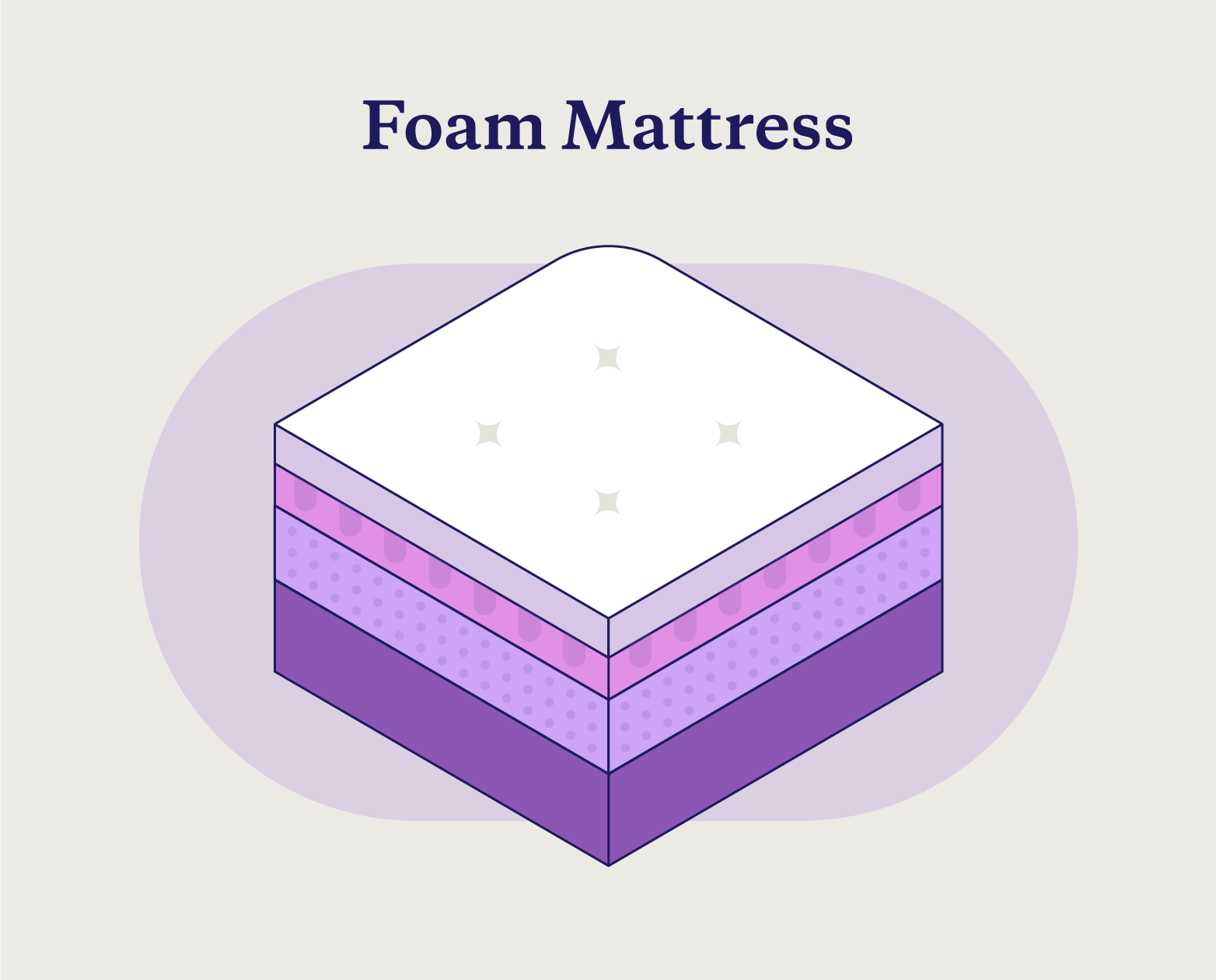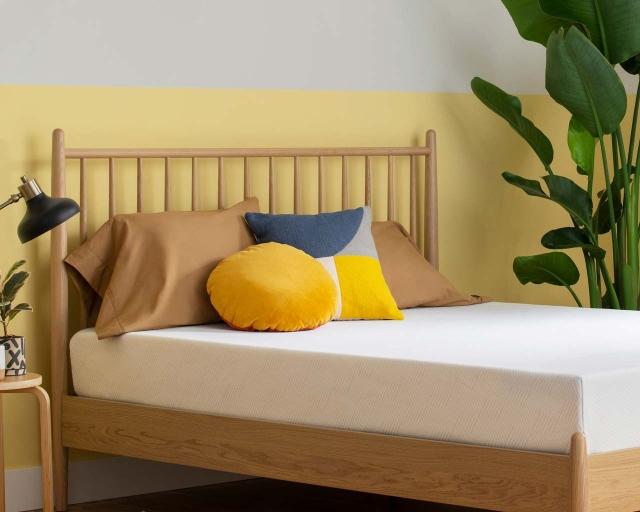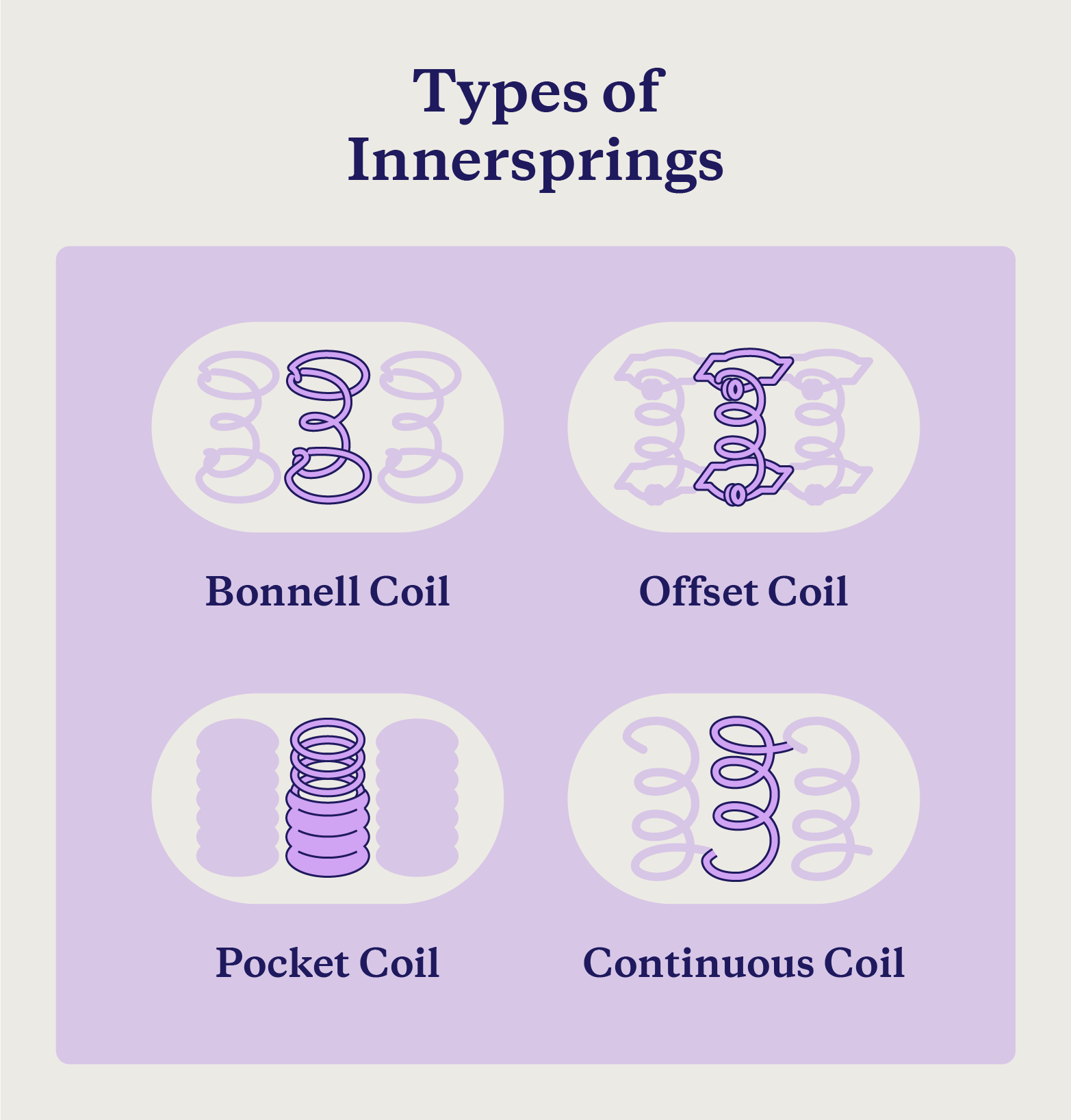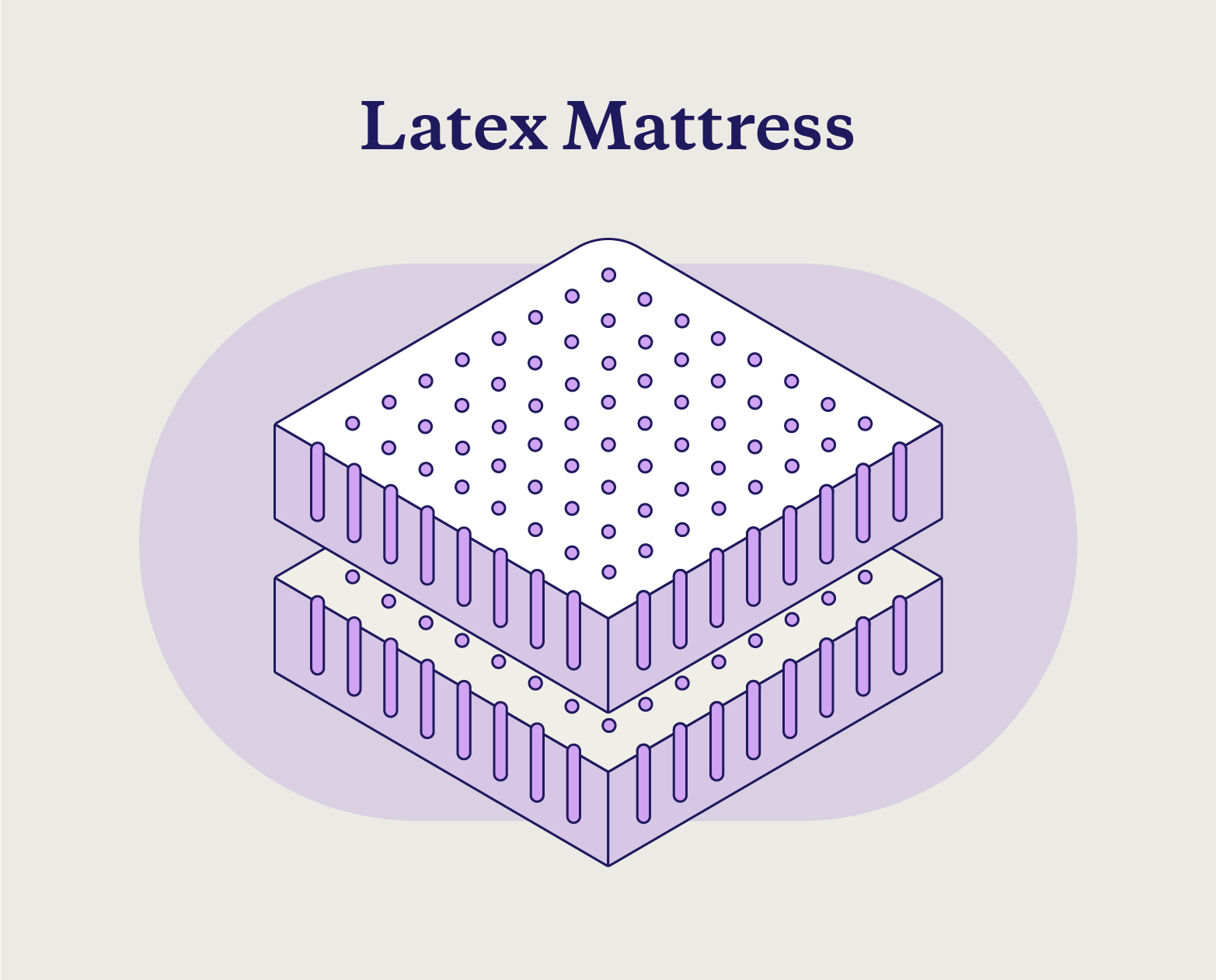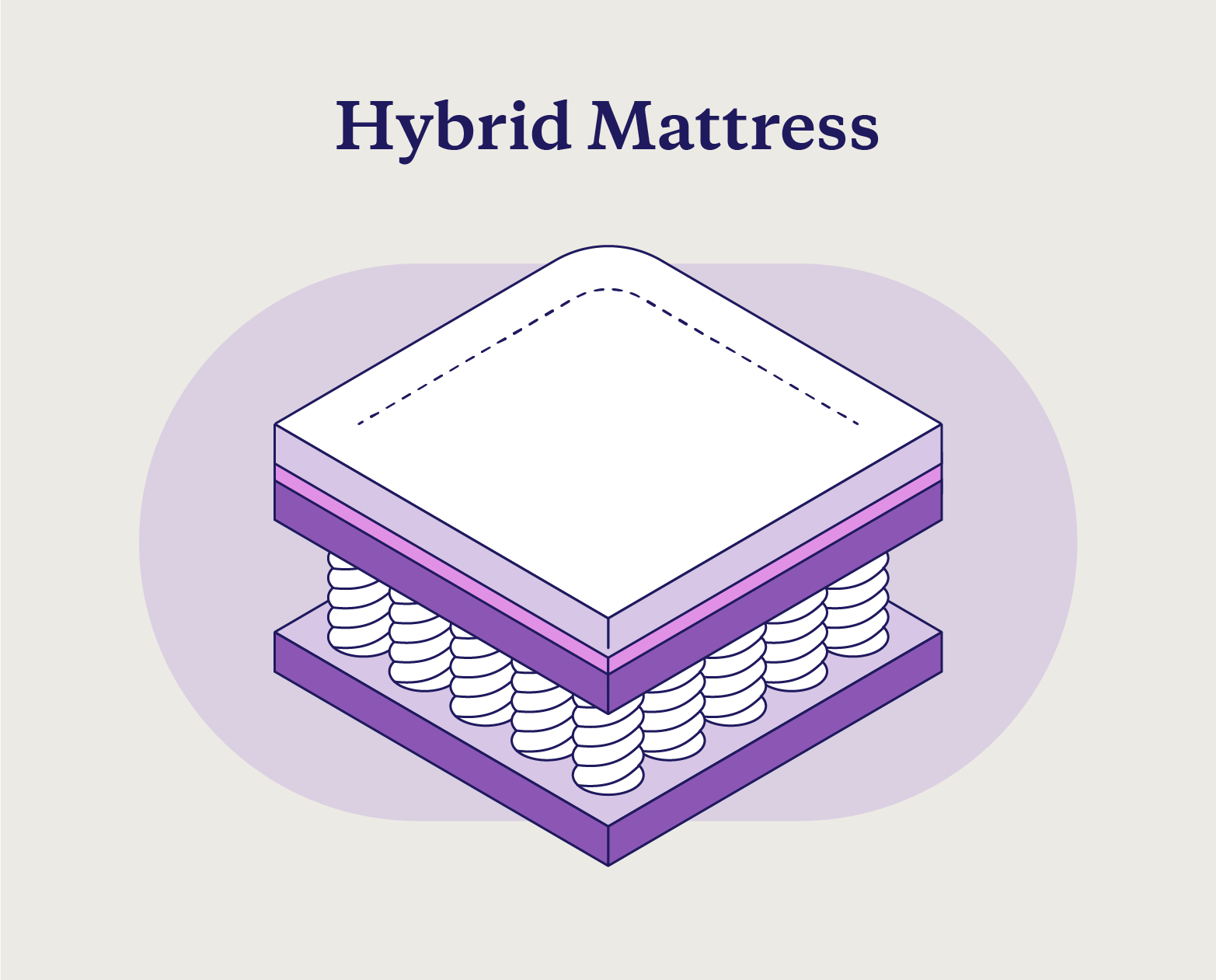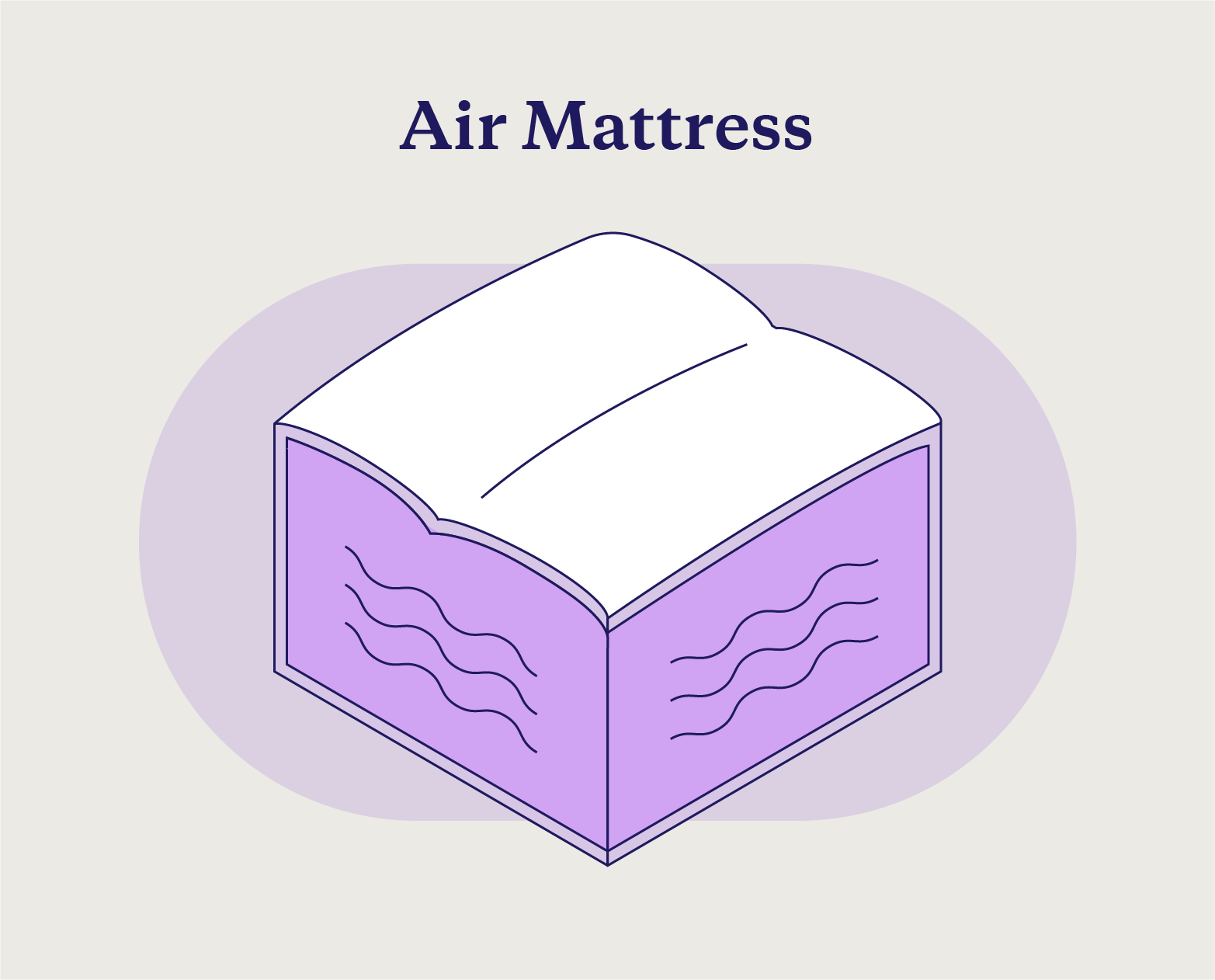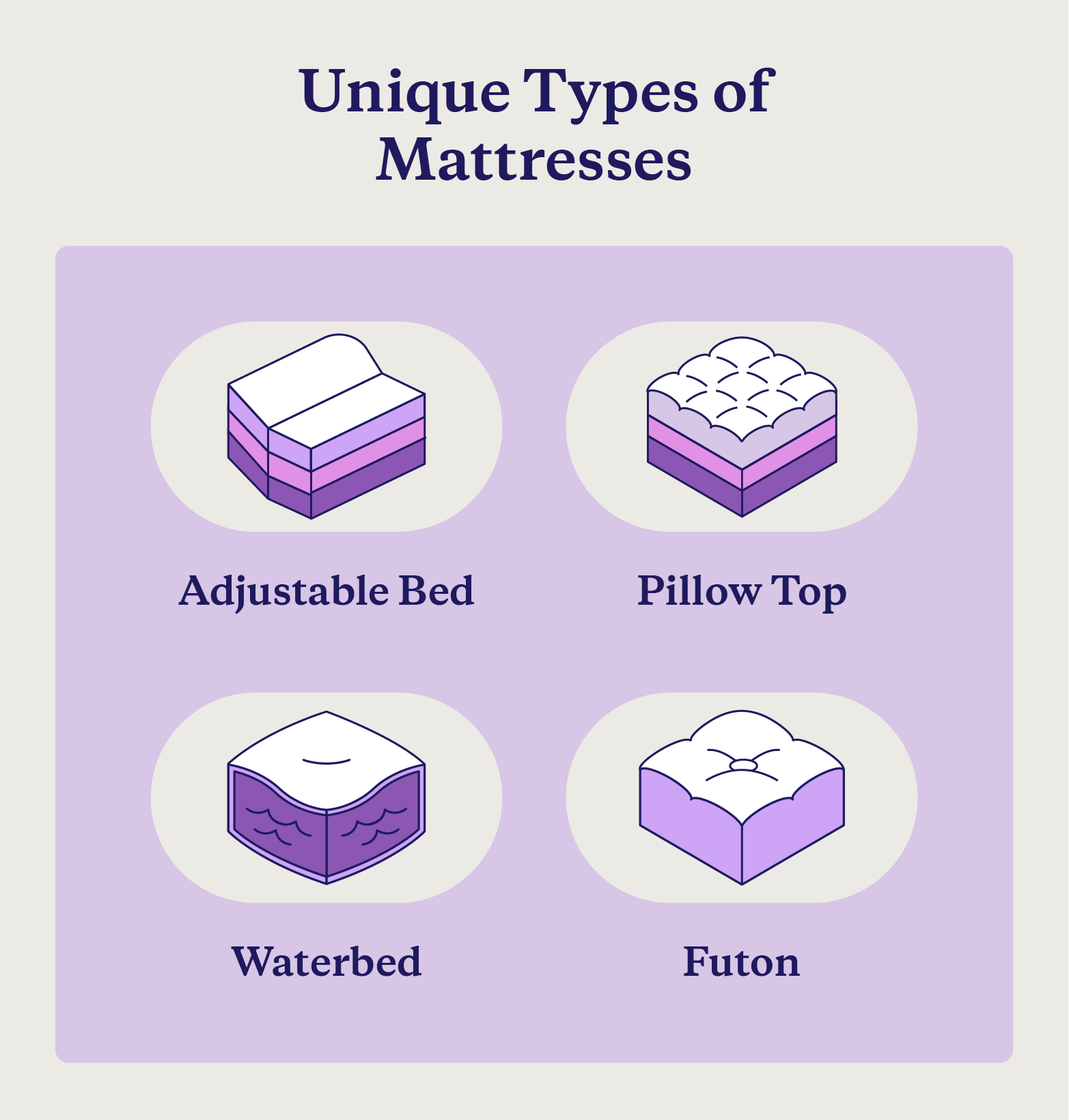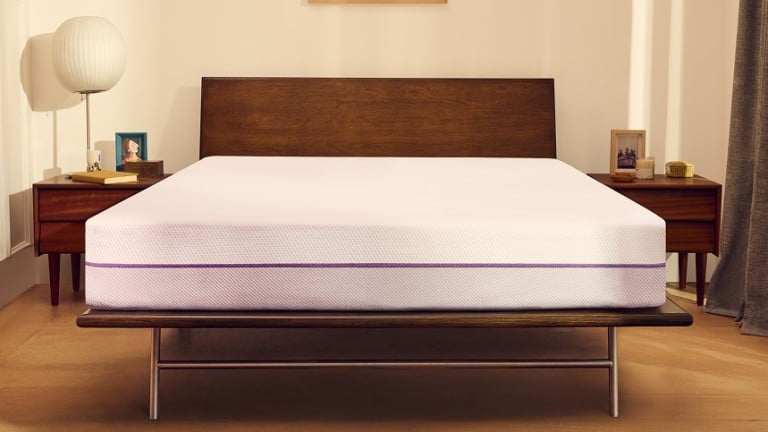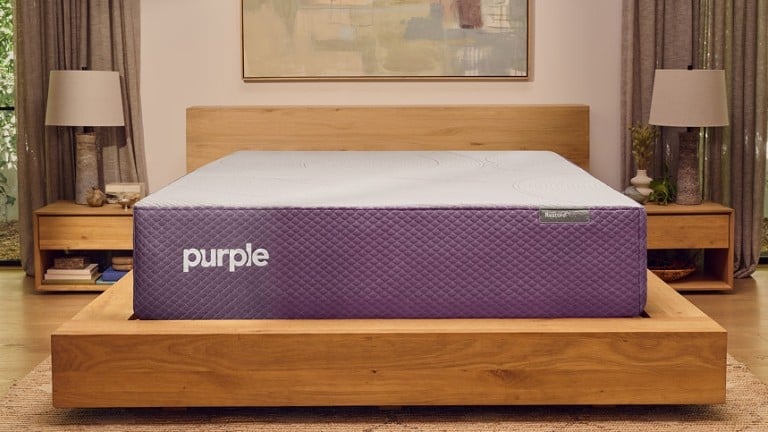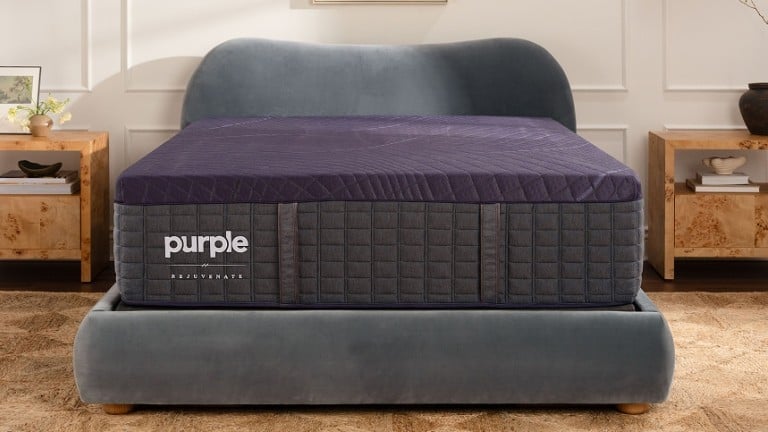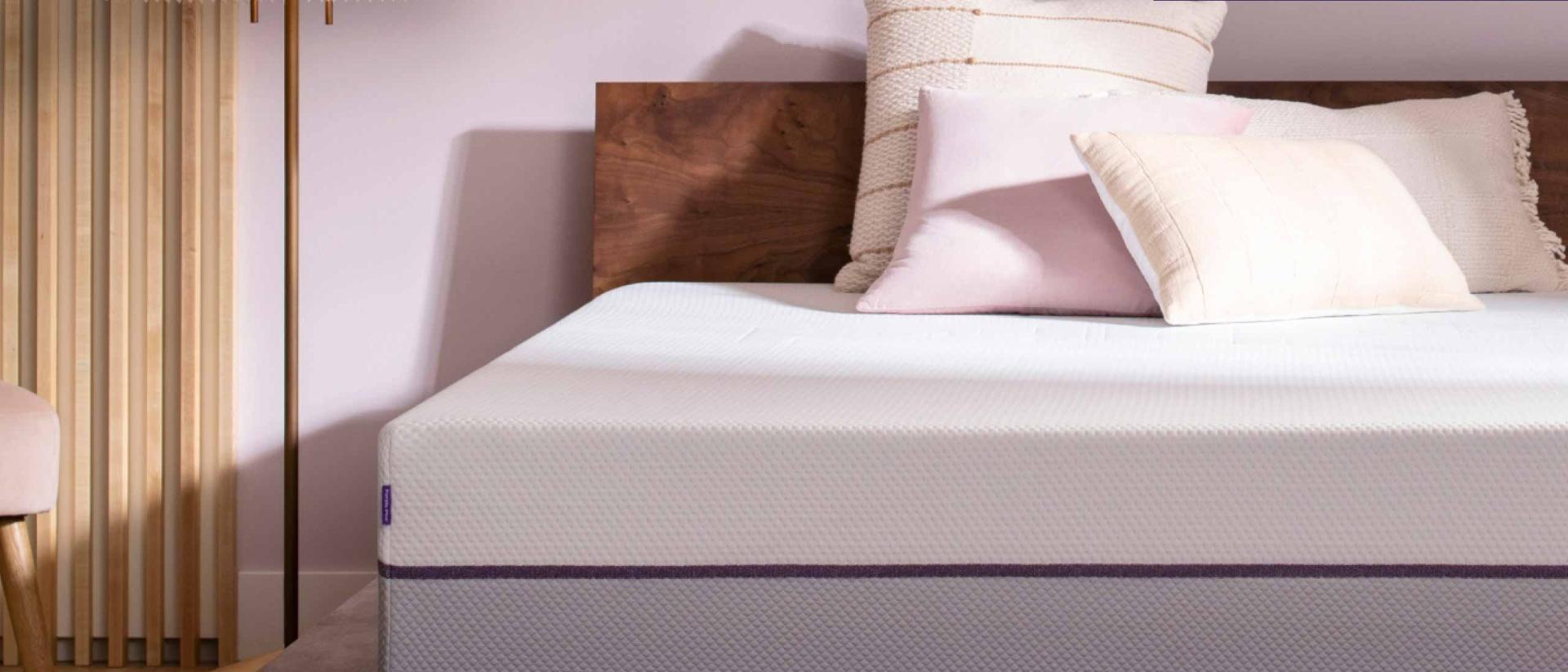
10 Types of Mattresses Explained: Pros and Cons of Each
Which type of mattress is best?
- The six most common types of mattresses are innerspring, foam, latex, hybrid, GelFlex® Grid, and air mattresses, with four alternative bed types available, as well.
- Each mattress type has unique benefits and considerations to keep in mind when investing in your sleep health.
- The best mattress for you depends on your unique needs, preferences, and sleep concerns, such as temperature regulation and pressure relief.
Shopping for a mattress without doing your research is like grocery shopping without a list — it can cause confusion, take extra time, and lead to the purchase of a mattress you’re ultimately not happy with. Not every mattress is created equal, and the different types of mattresses, sizes, materials, manufacturers, and brands can make choosing the right mattress overwhelming.
To simplify your online mattress shopping experience, consider your sleep wants and needs, your budget, each product’s durability, and the type of sleeper you are. There are six primary types of mattresses, as well as several less common alternatives:
Purple mattresses are unlike any other type of mattress on the market, with innovative layers designed to keep you cool and comfortable all night long. Try it for yourself to see why the GelFlex® Grid has earned Purple mattresses over 100K five-star reviews.
Read along to learn more about the benefits and considerations of each mattress type so you can confidently choose the best product for your needs.
1. GelFlex® Grid
Recommended for: Couples who want less motion transfer, individuals who tend to sleep hot, sleepers looking for the balance of pressure relief and full-body support
For individual sleepers and couples alike, Purple offers a variety of mattresses that feature our proprietary sleep innovation: the GelFlex® Grid. With instant adaptivity, temperature regulation, and responsive support, this patented technology puts our standard and hybrid mattresses a step above the rest.
Compared to other mattress materials like memory foam, the GelFlex® Grid is designed to dissipate body heat with a responsive feel that makes it easier for you to shift positions and get out of bed. Every Purple mattress features this proprietary sleep technology that revolutionizes sleep. Compare the different Purple mattresses to determine which is best for you.
Benefits | Considerations |
Innovative, proprietary sleep technology unlike any other on the market | Unique feel that may take time to get used to |
1,400 air channels promote airflow to balance your body temperature | High-quality materials and construction are available at a higher price point |
Hybrid models combine the GelFlex® Grid with pocket coils and comfort layers |
GelFlex® Grid Hybrid Mattresses
In addition to the GelFlex® Grid, Purple’s hybrid mattresses feature End-to-End Coils, an Advanced Edge Support System, and Ultra Comfort Foam for breathability. These combined features help sleepers get better rest and wake up rejuvenated.
Premier products, including the Purple RestorePremier™ Hybrid Mattress and the Purple RestorePlus™ Hybrid Mattress, utilize enhanced technologies to offer sleepers a soft but supportive feel, all the while the GelFlex® Grid cradles the body and increases airflow for everyday comfort.
Elevate your sleep with the luxurious Rejuvenate Collection, featuring hybrid mattresses that combine our revolutionary GelFlex® Grid with the added structure of pocketed coils and advanced comfort layers for the ultimate sleep experience.
2. Foam
Recommended for: Restless sleepers and those looking for an affordable, soft mattress
Rather than springs, foam mattresses use aerated materials to create a soft, supportive base for sleepers. Unlike spring mattresses, foam mattresses are designed to conform to the body, creating a “sinking” feeling that increases motion isolation.
The differences between spring and foam mattresses include pricing, joint support, pressure relief, and other features unique to each mattress type. While low-end foam mattresses can cost below $200, higher-end mattresses with better support and additional features like gel-infused foam can cost as much as $5,000.
Type of Foam Bed | Benefits | Considerations |
Memory foam mattress | Soft but supportive bed that reduces motion transfer | May retain body heat and contouring may be uncomfortable |
Polyfoam mattress | Lower price point than other foams with less of a sinking feel | Might be less durable on average and high-resilience options are more costly |
Gel memory foam mattress | Soft, supportive, and temperature-regulating with better motion isolation | May have a higher price point than other foam mattresses |
Types of Foam Mattresses
Foam mattresses grew in popularity after the invention of memory foam by the National Aeronautics and Space Administration (NASA) in the 1970s. They are highly durable, and a few of the most popular types of foam mattresses are:
- Memory foam: Memory foam mattresses are made of viscoelastic, a material that contours to an individual’s body and helps distribute weight equally.
- Polyfoam: Polyfoam mattresses are made of polyurethane foam, which is a lightweight, soft material often used as a comfort layer in spring mattresses.
- Gel-infused: Gel-infused foam mattresses are made of memory foam and a cooling gel designed to regulate temperature for hot sleepers.
Do you want to experience the adaptive pressure relief and other benefits of memory foam without any drawbacks? Our Essential Collection combines the GelFlex® Grid with comfort foam to cradle your pressure points without trapping heat, making them the perfect alternative to Casper foam mattresses.
3. Innerspring
Recommended for: Guest rooms, short-term housing, sleepers who need extra support, couples who move around a lot at night
Innerspring mattresses are the most well-known mattress type. They use steel coils covered by a softer protective material like wool or cotton to support a sleeper’s body weight. Ranging from $100 to $1,500, innerspring mattresses are typically cheaper than other options, making them affordable for all types of sleepers.
Despite their popularity, innerspring mattresses tend to be firmer and less durable than alternate options. These mattress types should last around 10 years, but additional weight, pressure (like jumping), and unnecessary stress can cause them to break down sooner. Before purchasing an innerspring mattress, consider how often and where you plan to use it.
Type of Innerspring Bed | Benefits | Considerations |
Bonnell coil mattress | Affordable with even support | Less durable and may be uncomfortable against pressure points |
Continuous coil mattress | Affordable, flippable, and durable | Minimal motion isolation and limited contouring |
Offset coil mattress | Supportive and soft | Higher price point than other coil mattresses |
Pocket coil mattress | Highly supportive with increased motion isolation | Higher price point than other coil mattresses |
Types of Innerspring Mattresses
All types of innerspring mattresses use some form of steel coil to support a person’s body weight during rest. To increase comfort, these springs are covered by soft materials like wool, cotton, foam, and latex. While innerspring mattresses have a shorter lifespan, many people value the supportive nature of an innerspring mattress.
There are four types of innerspring mattresses, each identifiable by its coil configuration:
- Bonnell coil: Considered one of the oldest and most common types of mattresses, Bonnell coil mattresses are composed of evenly distributed open coils shaped like an hourglass that connect using wire extensions.
- Continuous coil: Continuous coil mattresses use a single wire wound into loose, S-shaped coils to make an entire support framework.
- Offset coil: Offset coil mattresses use hourglass-shaped coils with flattened convolutions to create softer, better-conforming frameworks.
- Pocket coil: Marshall or wrapped coil mattresses are made of fabric-wrapped coils, which absorb pressure and minimize spring disruption.
4. Latex
Recommended for: Sleepers who want to invest in a durable, responsive bed
Covering the middle ground between innerspring and foam, latex mattresses are a springy yet contouring mattress option for sleepers. While generally more costly, they are breathable, supportive, and great for temperature regulation. The similarities between latex and memory foam mattresses make them an excellent option for sleepers looking for a soft, environmentally friendly mattress.
The lifespan of a latex mattress depends on its construction and materials, but a quality product should last close to 20 years. As one of the most durable mattress types on the market, latex mattresses are ideal for sleepers looking for a long-term, eco-friendly sleep investment.
Type of Latex Bed | Benefits | Considerations |
Organic | GOLS-certified, breathable, and temperature-balancing | Can aggravate latex allergies and may have the highest price of latex beds |
Natural | Uses natural materials with fewer additives for a breathable bed | Can aggravate latex allergies and may be more costly than other mattress types |
Synthetic | Breathable and temperature-balancing with a lower price point than natural latex | Can aggravate latex allergies, uses chemical additives, and may be more costly than other mattress types |
Blended | More affordable than natural and organic latex with fewer additives than synthetic | Can aggravate latex allergies, uses more chemicals than natural or organic, and may cost more than other mattresses |
Types of Latex Mattresses
Even though they use minimal additives and are nontoxic, sleepers with a latex allergy should not use latex mattresses. The materials used to create these mattresses can be separated into three categories:
- Organic: Organic latex mattresses are GOLS-certified products, meaning the mattress’s materials are gathered without the use of pesticides.
- Natural: Latex mattresses are made from natural products, using sap from rubber trees to create a frothy, foamy material.
- Synthetic: Synthetic latex mattresses are made of two petroleum-based compounds that combine to create styrene-butadiene rubber, which is potentially harmful.
- Blended: A combination of natural and synthetic latex results in a lower-cost mattress with the same bouncy feel.
In addition to the composition of latex used, there are two primary methods of filling a mattress mold, resulting in a different texture. These methods include:
- Dunlay: Manufacturers fill the mold with natural latex all at once without any fillers in a simple, efficient process that may result in inconsistent textures throughout the mattress.
- Talalay: The slower Talalay process fills the mold in layers with added chemicals and fillers to create a more even, springy feel.
5. Hybrid
Recommended for: Couples with different support needs, sleepers looking for a total package of pressure relief and structured support, and those who want to invest in a durable bed
Made from a combination of springs, foam, or latex, hybrid mattresses blend traditional support with contemporary features to create a responsive, supportive product. These hybrid models are incredibly versatile and can support various body types, sleeping positions, and temperature needs. Like innerspring mattresses, hybrid beds may be bouncier than other types, but hybrid mattresses tend to feature more comfort layers for better pressure relief and less noise.
Even with a base composed of metal coils, hybrid mattresses offer pressure point relief, motion isolation, and a comfortable top layer.
Type of Hybrid Bed | Benefits | Considerations |
Memory foam or polyfoam hybrid | Durable pressure point relief with back and joint support | Prone to heat retention, may contour too closely to the body for comfort, and offers less motion isolation than foam mattresses |
Gel-infused hybrid | Durable back and joint support with cooling pressure relief | May contour too closely to the body, offers less motion isolation, and may have a higher price point for gel technology |
Latex hybrid | Durable, responsive full-body support and pressure relief | One of the most expensive mattress materials that isn’t ideal for those with latex allergies |
GelFlex® Grid hybrid | Instantly adaptive full-body support and soothing pressure relief with advanced temperature regulation | High-end mattress with a unique feel |
Pocketed coils and a polyfoam framework make our base hybrid mattress model, the Purple Restore™ Hybrid Mattress, ideal for sleepers who want a hybrid product with increased firmness, instant response support, and temperature regulation.
6. Air Mattresses and Air Beds
Recommended for: Air mattresses are great for temporary sleeping arrangements while air beds appeal to couples with different firmness and elevation preferences.
Air mattresses are inflatable mattresses. This type of bed is lightweight and typically portable, and no matter what size or mattress thickness you prefer, you can find various options. While they can be inflated manually, air compressors and pumps can inflate these products within minutes.
Air mattresses work well for temporary sleeping and resting needs. You can quickly adjust the mattress’s firmness by adding or removing air, and it can be stored away in small spaces when not in use.
Benefits | Considerations |
Inexpensive | Not very durable |
Convenient short-term sleeping option | Provides little comfort and support |
Easy to set up and store | May be prone to leaking or deflating overnight |
Air beds, on the other hand, offer more structure and durability than a standard air mattress, allowing sleepers to customize their sleep experience with the push of a button.
Benefits | Considerations |
Customizable firmness levels | Can be more expensive than other standard mattresses |
Split options are great for couples with different preferences | Air-filled channels may not be as comfortable as other materials |
Looking for an alternative to Sleep Number mattresses and other air beds? Our Restore Hybrid Collection provides comparable soothing comfort and adaptive support without the need to manually adjust mattress firmness. Paired with one of our easy-to-use adjustable bases, our hybrid mattresses offer customization for the ultimate sleep experience tailored to your needs.
Alternative Mattress Types
Mattresses that don’t fit into the six categories described above are typically classified as alternative mattresses, as they have features and characteristics that set them apart. While unconventional, these alternative mattress types are commonly used by a variety of sleepers.
Adjustable Beds
Recommended for: Sleepers looking for customizable sleep solutions and maximum comfort
Adjustable beds typically refer to the combination of an adjustable base with a softer, flexible mattress that can be repositioned more easily than firmer mattresses. An adjustable bed can be repositioned for increased comfort, allowing for a customized sleep experience. This type of sleep product can feature preset positions and massage settings for maximum relaxation.
Purchasing an adjustable bed frame and mattress from the same manufacturer can ensure product compatibility and improve sleep quality and comfort.
Pillow Top Mattress
Recommended for: Anyone who wants a softer, thicker sleep surface
Pillow top mattresses are standard mattresses with an additional padded attachment on top of the mattress cover. These mattresses provide additional pressure relief and comfort to standard mattresses and are often compared to Euro top mattresses.
Pillow top mattresses are an affordable option for sleepers looking for optimal comfort that still prioritizes body alignment, weight distribution, and pain relief.
Previously, Purple Rejuvenate Luxe Mattress models all featured a quilted Euro Top, however, our new design, (launched 2025), removed the pillow top for an entirely new top layer technology. The DreamLayer™, an airy, micro-scale version of the GelFlex Grid, which promotes comfort and temperature regulation.
Waterbed
Recommended for: Single sleepers who sleep hot and want a soft mattress
A waterbed uses water instead of springs, foam, or latex as support. Some waterbeds use tubes or bladders to distribute the filling and create a highly supportive contouring base. Ranging from $50 to $2,000, this type of mattress rose to fame in the 1980s. Though it’s not as common as it used to be, unique features like its unique feel and temperature control keep this alternative mattress a popular option for some sleepers.
Futon
Recommended for: Smaller sleeping areas and individuals with limited space looking for guest sleeping accommodations
A futon is a flexible, mobile mattress that is usually attached to a movable frame. This product can be used as both a couch and a bed, which makes it a versatile piece of furniture for small living spaces. Similar to standard mattresses, futons are available in various sizes, thicknesses, shapes, colors, and materials, as are the frames they sit on.
Many sleepers also cover futons with a duvet or other covering to protect the mattress from everyday wear and tear.
How To Choose the Best Mattress Type for You
Choosing a mattress is an important decision. To determine which mattress type is best for you, prioritize the features and considerations you need for restful, restorative sleep, including:
Comfort
What feels best for you may vary depending on your needs, concerns, and preferences. While comfort can be subjective, look for a mattress that provides the pressure relief, contouring, and responsiveness you need to sleep comfortably.
Support
The amount of support you feel from a mattress is also subjective, though it may relate to features like pushback (how much resistance you feel from the bed when you lie down) and spinal alignment (how well the mattress prevents your spine from bending too much or too little).
Several factors can affect how supportive a mattress feels to you, such as:
- Your sleep position: Sleepers with different preferred positions may find some mattresses too soft or too hard, resulting in discomfort and misalignment.
- Your weight: How much you weigh can impact how your mattress feels, with heavier individuals experiencing less pushback on softer mattresses than lighter sleepers.
- Your foundation: Using the wrong mattress foundation or bed frame can reduce the structural integrity of your mattress, causing it to sag prematurely and offer less support.
Keep mattress weight limits in mind, as well, to ensure your mattress can comfortably and safely support your body without wearing out or causing you pain.
Responsiveness and Bounce
Bouncy, springy, and responsive mattresses may be a good fit for combination sleepers who change position overnight, as well as anyone who experiences difficulty getting out of bed.
If you’re looking for a mattress with bounce and you sleep with a partner, it may be worth prioritizing options that reduce motion transfer so you can sleep without interruption.
Your Sleep Position
How you sleep impacts the mattress you invest in. Stomach, side, and back sleepers need different levels of support to get their best sleep, so consider how you tend to fall asleep and where you may need the most spinal alignment support and pressure relief.
Personal Preferences
As you narrow down your mattress options, be sure to consider personal preferences for factors like:
- Mattress thickness
- Mattress firmness or softness
- Motion isolation
- Individual support needs
- Pressure relief preferences
Your preferences and needs may differ from those of other shoppers or even your partner, so it’s important to determine what you want and need to sleep well.
Mattress Size
Your height, sleeping space, and current bed frame all influence the size of your mattress, which can affect the type of mattress you purchase. Larger mattress sizes tend to have higher price points than smaller options. If you’re looking for an oversized mattress, you may have a smaller variety of mattress types to consider, as these beds tend to require a custom order.
Mattress Foundation
Whether you choose to keep or replace your bed’s foundation will impact which mattress you need for comfortable, versatile sleep. Whether you’re upgrading to an adjustable base or opting for a platform bed, be sure to pick a mattress that your foundation can safely support.
Budget
High-quality and highly durable mattresses will cost more than conventional options. Purchasing a mattress is an investment in your sleep quality. Be sure to choose a bed that offers the features you need to get the restorative sleep you need.
What Is the Best Type of Mattress?
The best mattress type is specific to your needs and preferences for firmness, feel, special features, and overall comfort. After you’ve narrowed down the features essential to your sleep habits, consider testing a mattress in store. This firsthand experience can help you make an informed decision before committing to a long-term sleep product.
With hybrid constructions, luxurious comfort layers, and essential pressure relief options, Purple mattresses are a great choice for all types of sleepers — no matter your preferences, needs, or budget.
FAQ
There are at least 10 different types of mattresses, including:
- Innerspring or coil
- Foam
- Latex
- Hybrid
- GelFlex Grid
- Air mattress and air bed
- Adjustable
- Pillow top
- Waterbed
- Futon
Deciding what type of mattress is best for sleeping night after night means determining what you need and want out of a mattress. You can narrow down your options by considering:
- What size mattress you want
- Your preferred sleeping position
- Whether you sleep alone or with a partner
- Your personal comfort and support preferences
- The ideal feel and firmness of your mattress
- What mattress foundation or base you want to use
Because mattress preferences are subjective, there is no one best mattress material. Latex and hybrid mattresses are among the most popular options because they combine pressure relief and responsiveness.
For the ultimate blend of comfort and support, the GelFlex® Grid in every Purple mattress instantly adapts to your body. It draws heat away from your skin, providing a soothing, temperature-neutral sleep experience.
Though innerspring and foam mattresses have been popular, both options have become less common because of their drawbacks. Foam mattresses may be better for some sleepers looking for more pressure relief and a contoured feel, but sleepers who shift position and want more pushback may prefer a spring mattress.
If you’re between the two, consider a hybrid option like the Purple Restore Hybrid Collection, which blends a pocketed coil structure with comfort layers to support your body and relieve pressure at the same time.
Latex mattresses are among the most durable types of mattresses available, lasting up to 15 years with proper care and support. If you take good care of your mattress and use the recommended type of foundation, most mattresses can last up to 10 years before you need to replace them.
The most comfortable mattresses relieve your pressure points, promote spinal alignment, and allow you to move easily as you shift positions or get out of bed. While your comfort is subjective and may vary depending on your individual needs, the GelFlex® Grid offers adaptive support, soothing pressure relief, and a responsive feel for the ultimate sleep experience.
More to Explore
Level-up your sleep routine with our most-loved products.



